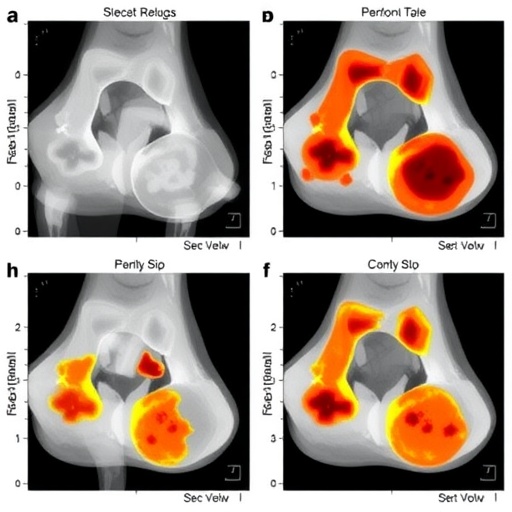In the sphere of orthopedic research, advancements are constantly shaping our understanding of joint mechanics and the intricate behaviors of cartilage, specifically under conditions of stress and repair. A recent study delving deep into these dynamics has garnered attention. The research, spearheaded by Lin, Wang, and Liu, explores the stress behaviors of cartilage that is both defective and repaired in the context of total knee joint under compression loading. This ongoing pursuit to unravel the complexities of cartilage mechanics has significant implications for the treatment and management of joint injuries, particularly in the knee.
The study notably investigates how cartilage behaves under compressive loads when it has sustained damage versus when it has undergone repair. Cartilage is a unique connective tissue that acts as a cushion between bones, especially in load-bearing joints like the knee. When cartilage is damaged—whether due to acute injury or chronic conditions such as osteoarthritis—it can lead to pain, decreased mobility, and overall joint dysfunction. Understanding how this tissue responds to mechanical loads post-injury and repair is crucial in developing effective strategies for rehabilitation and surgical intervention.
Using advanced methodologies, the authors conducted experiments that simulated realistic loading conditions that knee joints encounter during daily activity. This involved both in vitro and computational models that provide a comprehensive understanding of how cartilage reacts. The researchers meticulously analyzed the stress distribution within the cartilage tissue under various loading scenarios. Their findings revealed significant differences in stress behaviors between healthy and damaged cartilage, underscoring the latter’s vulnerability to mechanical strain.
The research further emphasizes that the process of repairing damaged cartilage is not merely about restoring physical integrity. Instead, it’s crucial to consider how the repaired tissue can withstand stress without faltering under load in the long term. This is particularly relevant for patients recovering from knee surgeries aimed at cartilage repair or replacement. The authors propose that effective rehabilitation protocols should account for these stress dynamics to optimize recovery outcomes and enhance joint function post-surgery.
Interestingly, the team’s findings indicate that the mechanical properties of repaired cartilage do not always return to baseline levels, which can have profound implications on the longevity of surgical repairs. As such, clinicians and researchers alike are urged to re-evaluate the criteria used to assess cartilage repair techniques. The benchmark for successful recovery may need to include not just structural repair but also functionality under real-world loading conditions.
Another intriguing aspect of the study is the potential role of biophysical factors in the cartilage repair process. The researchers suggest that enhancing the biochemical environment surrounding the cartilage, such as optimizing nutrient levels and cellular activity, could improve the healing outcomes and restore the mechanical properties necessary for proper joint function. This opens doors to novel therapeutic strategies that go beyond conventional surgical means.
This study has several practical applications that could reshape clinical practices. For instance, it may influence how orthopedic surgeons approach surgical techniques for cartilage repair, as well as how rehabilitation protocols are designed post-operation. Patients, practitioners, and researchers are likely to benefit from a more nuanced understanding of how cartilage mechanics can dictate the success of joint repairs and overall long-term health.
Moreover, as the study emphasizes the necessity for further exploration into the specific cellular and molecular mechanisms that influence cartilage repair under stress, it invites a new wave of research. It highlights a gap in current knowledge about the interplay between mechanical loads and biological responses, suggesting that a multidisciplinary approach incorporating biomechanics, cellular biology, and material sciences may yield innovative solutions.
Future studies could also delve into patient-specific factors that may affect recovery outcomes. For instance, age, lifestyle, genetic predispositions, and even body weight are all factors that could influence how an individual’s cartilage adapts to strain post-repair. As personalized medicine continues to evolve, these considerations will become increasingly vital in tailoring treatment plans for optimal recovery.
In conclusion, the intricate dance between cartilage structure, its response to mechanical stress, and the subsequent healing processes presents an exciting frontier in orthopedic research. The findings from Lin and colleagues challenge existing paradigms and encourage a reassessment of cartilage repair methods and rehabilitation approaches. As the scientific community continues to unravel these complexities, one thing is clear: understanding and improving cartilage mechanics is crucial for enhancing recovery protocols for millions of individuals affected by knee joint injuries each year.
Moving forward, it’s expected that this area of research will continue to evolve rapidly. As new technologies emerge, particularly in imaging and biomechanical modeling, our capacity to understand the behavior of cartilage under various conditions will expand. This may lead to groundbreaking innovations in both surgical techniques and postoperative rehabilitation strategies, ultimately transforming the quality of care for individuals suffering from joint diseases.
In sum, the discourse surrounding cartilage mechanics in the context of injury and repair is critical; it not only informs clinical practices but also underscores the importance of ongoing research. As we deepen our understanding of these complex biological systems, we pave the way toward more effective treatments that can significantly improve patients’ quality of life.
Subject of Research: Stress behaviors of cartilage with defect and after repair under compression loading
Article Title: Stress Behaviors of Cartilage with Defect and After Repair in Total Knee Under Compression Loading
Article References: Lin, X., Wang, S., Liu, B. et al. Stress Behaviors of Cartilage with Defect and After Repair in Total Knee Under Compression Loading. J. Med. Biol. Eng. (2025). https://doi.org/10.1007/s40846-025-00997-6
Image Credits: AI Generated
DOI: https://doi.org/10.1007/s40846-025-00997-6
Keywords: cartilage mechanics, knee joint, compressive loading, cartilage repair, orthopedic research




